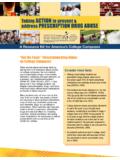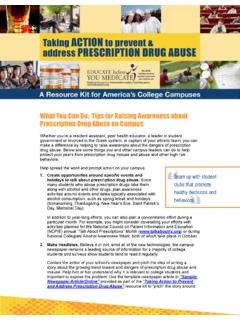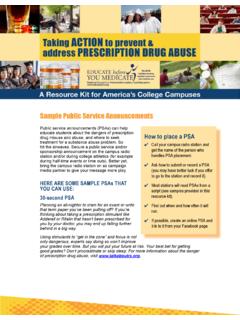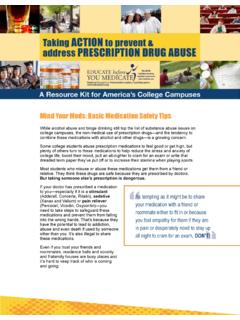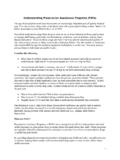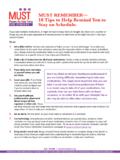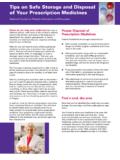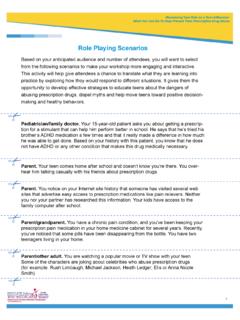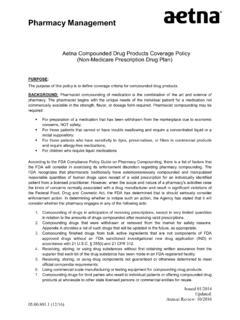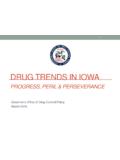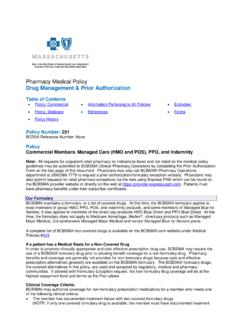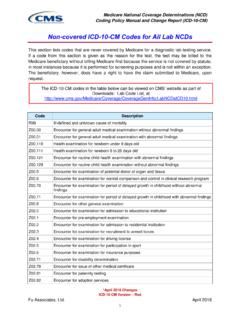Transcription of A National Action Plan to Address America’s …
1 Accelerating Progress in prescription Medicine Adherence: The Adherence Action Agenda A National Action plan to Address america 's Other drug Problem . October 2013. Copyright 2013 by National Council on Patient Information and Education. All rights reserved. No part of this report may be reproduced or utilized in any form or by any means, electronic or mechanical, in- cluding photocopying, recording, or by any information storage or retreival system, without permission in writing from the publisher. Inquiries should be addressed to: National Council on Patient Information and Education 200-A Monroe Street Suite 212. Rockville, MD 20850-4448. 301-340-3940. Printed in the United States of america . Contents 2 Preface 4 Executive Summary 8 Introduction 12 Multiple Chronic Conditions and Medication Adherence: The Perfect Storm 16 Key Factors Behind Poor Adherence: What's New? 23 The Triggers for Action 28 Advancing Medicine Adherence With a Focus on Multiple Chronic Conditions: The New Adherence Action Agenda 34 Adherence Action Agenda Members 35 References Preface Lack of prescription medicine adherence can be considered america 's other drug problem, leading to unnecessary disease progression, disease complications, reduced functional abilities, a lower quality of life, and even possibly premature death.
2 Such downstream effects also increasingly contribute to our overall National health expenditures. That is why in 2007, the National Council on Patient Information and Education (NCPIE) issued Enhancing prescription Medicine Adherence: A National Action plan . Calling for a National mobilization to reduce the adverse health and economic consequences associated with this pervasive public health threat, the report documented the numerous behavioral, social, economic, medical, and policy- related factors that contribute to patients not taking their medicines as prescribed and released a ten-step blueprint for Action across the continuum of care from diagnosis through treatment, and follow-up patient care and monitoring. Since NCPIE's National Action plan was released six years ago, there has been significant progress in meeting many of the priorities called for in the report, especially in the areas of public education, new resources for health providers, and public policy initiatives.
3 Such progress represents good news, even as we anticipate that america 's other drug problem will take on new dimensions due to a dramatic rise in the number of older Americans and a dramatic increase of costly age-related chronic illnesses. Already the number of adults aged 65 and over increased from 35 million in 2000 to 40 million in 2010 (a 15% increase) and it is estimated that as many as 55 million Americans will be over the age of 65 by Because aging is directly correlated with the increased prevalence of chronic disease, the United States is witnessing an epidemic of persons with multiple chronic conditions. As a result, a growing number of Americans are now taking numerous prescription medicines on a daily basis, often see more than one prescriber, and thus are at significantly higher risk for drug - drug interactions, adverse events and medication errors. Looking specifically at the nation's health care bill, researchers and public health experts put the avoidable costs associated with mismanaged medication use among patients with multiple chronic conditions at $ billion a year,2 an amount that will only increase unless the quality of medication prescribing and medication use including medicine adherence is substantially improved.
4 Recognizing the high costs of caring for Americans with multiple chronic conditions, the Department of Health and Human Services (HHS) convened a working group to Address this challenge, especially in light of related Patient Protection and Affordable Care Act (ACA) initiatives, and in 2010, published a strategic framework for federal efforts to improve the health of individuals living with concurrent chronic diseases. But while HHS has elevated multiple chronic conditions as a priority concern, what remains lacking is a clearer understanding of the inter-relationship between multiple chronic conditions and poor adherence, a linkage that may represent a major public health threat. To document what is at stake, NCPIE convened representatives of 22 professional societies and voluntary health organizations, government agencies and industry leaders to review the state of adherence today and identify the major challenges for the future. Their comprehensive assessment led to a consensus that confronting the combined threat of poor prescription medicine adherence and higher rates of multiple chronic conditions requires priority attention and Action before the predicted increase of multiple chronic conditions overwhelms the health care system.
5 This report presents the findings of NCPIE's new comprehensive review, providing up-to-date information on the state of prescription medicine adherence in the , the extent and impact of multiple chronic medical conditions on appropriate medicine use, and what may materialize in terms of excess morbidity, mortality and 2 N ATI O N A L C O U N C IL ON PAT IENT INFORMAT ION AND EDUC ATI O N. rising health care costs if steps are not taken quickly to improve patient adherence among Americans coping with two or more chronic illnesses. And because the stakes are so high, the report lays out a new Adherence Action Agenda to coalesce stakeholders around the common goal of improving patient adherence to reduce the burden of chronic disease. Ultimately involving the support and active participation of many constituencies . the federal government, state and local government agencies, professional societies, healthcare practitioners, health educators, health systems, insurers and patient advocates it is hoped that this report will serve as a catalyst for Action and provide a blueprint for accelerating progress.
6 ACCEL ERAT ING PROGRESS I N P RESC RI P TI O N M EDI C I NE ADHERENC E: THE ADHERENC E AC TI O N A G E N DA 3. Executive Summary At the same time that medical science has those Action steps that will have the greatest impact transformed HIV and many cancers into treatable in improving medicine adherence over the next conditions and significantly reduced the burden decade. of chronic diseases like diabetes, many Americans are not benefiting from these treatment advances Towards this end, in the fall of 2012, NCPIE. due to the persistent problem of poor prescription commenced a new initiative called the Adherence medicine adherence a pervasive problem the Action Agenda or the A3 Project, bringing together leads to unnecessary disease progression, disease 22 professional societies and voluntary health complications, a lower quality of life, preventable organizations, government agencies and industry deaths, avoidable medical spending and lost work leaders to review the state of adherence today and productivity.
7 Identify the major challenges for the future. The comprehensive assessment led to a consensus that To Address this complex and multifaceted public confronting the combined threat of poor prescription health problem, in 2007, the National Council medicine adherence and higher rates of multiple on Patient Information and Education (NCPIE) chronic conditions requires immediate attention and issued Enhancing prescription Medicine Adherence: Action before the predicted increase of multiple A National Action plan , which defined poor chronic conditions overwhelms the health care medication adherence as the nation's other drug system. The findings of this comprehensive review problem and identified ten- Action steps to reduce include the following: its adverse health and economic consequences. Intended as a catalyst for Action , the 2007 report was the genesis for important progress in areas such THE PAYS A HIGH PRICE. as public education programs, new resources and FOR POOR ADHERENCE.
8 Tools for health professionals, extensive research Based on the latest estimates, half of the estimated and a number of policy initiatives. Adding to 187 million Americans who take one or more these developments, there is now a growing body prescription medicines or up to million of evidence on the cost effectiveness of medicine patients do not take these drugs as prescribed. In adherence, including a recent report from the fact, studies show that 20% to 30% of prescriptions Congressional Budget Office (CBO) that credits are never filled by patients, while 50% 60% of greater usage of medications by persons enrolled in medications to treat chronic disease are not taken Medicare Part D drug plans with reduced health care as prescribed. In terms of the toll in morbidity costs. and mortality, lack of medication adherence is associated with poorer health outcomes, resulting Yet, even as these important efforts are having an in approximately 125,000 preventable deaths a year impact, nonadherence in the continues to be at and many as 40% of nursing home admissions in unacceptable levels and will only be compounded people with type 2 diabetes.
9 From the standpoint in the days ahead by an aging society and a looming of the cost to the economy, new research estimates epidemic of age-related chronic diseases. This is that $105 billion is wasted annually on medication especially true of multiple chronic conditions where therapy nonadherence of which 69% or $ older adults tend to take multiple drugs on a daily billion is spent on hospitalizations. Other findings basis, have more than one prescriber, and are at project that poor medicine adherence, along with increased risk of drug interactions, adverse events suboptimal prescribing, drug administration, and and errors in taking their medicines as prescribed. diagnosis, costs the health care system an estimated Thus, it is a necessary time to re-examine the state $290 billion per year in avoidable medical spending of medicine adherence, identify the major gaps in and lost work productivity, translating into 13. current adherence efforts, and create consensus on percent of total health care expenditures.
10 4 N ATI O N A L C O U N C IL ON PAT IENT INFORMAT ION AND EDUC ATI O N. MULTIPLE CHRONIC CONDITIONS report are the complexity of the drug regimen, cost-control measures implemented by payers and AND POOR MEDICINE ADHERENCE. health systems, the need for patients to visit multiple REPRESENT THE PERFECT STORM pharmacies to fill different prescriptions, poor Driven by the aging of the population and such communication between patients and clinicians, risk factors as increased obesity, the prevalence of and the breakdown in provider communications multiple chronic conditions is on the rise along during the transition of care from the hospital to the with polypharmacy, defined as the use of multiple outpatient setting. medications. Today, 27% of Americans are living with multiple chronic conditions (MCC), including one in 15 children. However, the heaviest burden is IMPORTANT CHANGES IN THE. among Americans aged 65 and older where recent DELIVERY OF HEALTH CARE HAVE.
